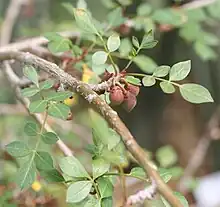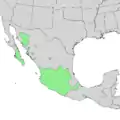Bursera fagaroides
Bursera fagaroides is a species of flowering plant in the genus Bursera known by the common names torchwood copal and fragrant bursera.[4] It is widespread across much of Mexico from Sonora to Oaxaca, and its range extends just into Arizona in the United States, although some sources suggest that it may now be extirpated in Arizona.[4][5][6]
| Bursera fagaroides | |
|---|---|
 | |
| Scientific classification | |
| Kingdom: | Plantae |
| Clade: | Tracheophytes |
| Clade: | Angiosperms |
| Clade: | Eudicots |
| Clade: | Rosids |
| Order: | Sapindales |
| Family: | Burseraceae |
| Genus: | Bursera |
| Species: | B. fagaroides |
| Binomial name | |
| Bursera fagaroides | |
| Synonyms[3] | |
|
List
| |
This plant is a shrub or tree growing up to 10 meters (33 feet) tall. The trunk is swollen, with peeling red-tinged bark. The leaves are pinnate, each made up of 5 to 11 leaflets. The flowers are borne singly or in clusters at the ends of branches and are white, sometimes with a yellow or greenish tint. The gray-brown triangular fruit is about 6 millimeters long and splits open when ripe to release a reddish seed.
Bursera fagaroides is similar in appearance to the elephant tree (Bursera microphylla), but can be differentiated by its longer, narrower leaflets.[4]
This plant grows in the scrub of the Sonoran Desert. Farther south in Mexico it can be found in arroyos in subtropical scrub habitat. It is found in shallow soils and rocky substrates, often limestone.[4]
The seeds are consumed by birds such as the white-eyed vireo (Vireo griseus), and the grey catbird (Dumetella carolinensis).[7]
This species is grown as an ornamental plant and can be sculpted into bonsai.[4]
Uses
In Mexico, the gum from the tree has been used in treating scorpion stings and insect bites.[8]
References
- IUCN SSC Global Tree Specialist Group; Botanic Gardens Conservation International (BGCI) (2020). "Bursera fagaroides". IUCN Red List of Threatened Species. 2020: e.T148948270A148952198. doi:10.2305/IUCN.UK.2020-1.RLTS.T148948270A148952198.en. Retrieved 8 April 2023.
- "NatureServe Explorer 2.0". explorer.natureserve.org. Retrieved 8 April 2023.
- The Plant List, Bursera fagaroides (Kunth) Engl.
- Bursera fagaroides. Archived 2014-09-16 at the Wayback Machine Plant Abstracts. Arizona Game and Fish Department.
- SEINet, Southwestern Biodiversity, Arizona chapter
- Biota of North America Program 2014 county distribution map
- Ortiz-Pulido, R. and V. Rico-Gray. (2006). Seed dispersal of Bursera fagaroides (Burseraceae): The effect of linking environmental factors. The Southwestern Naturalist 51(1) 11-21.
- Standley, Paul C.; Blake, S. F. (1923). "Trees and Shrubs of Mexico (Oxalidaceae-Turneraceae)". Contributions from the United States National Herbarium. Washington, D.C.: Department of Botany, Smithsonian Institution. 23 (3): 549. JSTOR 23492504.
External links
- NatureServe. 2014. Bursera fagaroides. Plant Abstracts. Arizona Game and Fish Department.
- Bursera fagaroides var. elongata. Arizona-Sonora Desert Museum.
- photo of herbarium specimen at Missouri Botanical Garden
Further reading
- Becerra, J. X.; D. L. Venable (2008). Rees, M. (ed.). "Sources and sinks of diversification and conservation priorities for the Mexican tropical dry forest". PLOS ONE. 3 (10): e3436. Bibcode:2008PLoSO...3.3436B. doi:10.1371/journal.pone.0003436. PMC 2562985. PMID 18927613.



